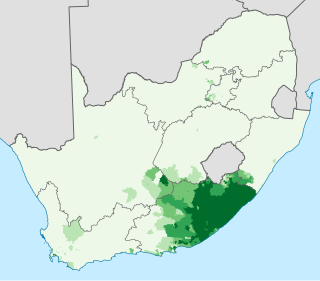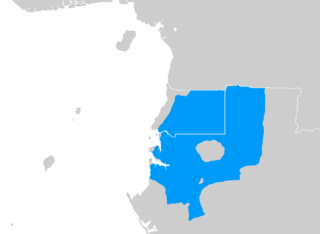Related Research Articles

Tswana, also known by its native name Setswana, is a Bantu language spoken in Southern Africa by about 8.2 million people. It belongs to the Bantu language family within the Sotho-Tswana branch of Zone S (S.30), and is closely related to the Northern Sotho and Southern Sotho languages, as well as the Kgalagadi language and the Lozi language.
Tone is the use of pitch in language to distinguish lexical or grammatical meaning – that is, to distinguish or to inflect words. All verbal languages use pitch to express emotional and other paralinguistic information and to convey emphasis, contrast and other such features in what is called intonation, but not all languages use tones to distinguish words or their inflections, analogously to consonants and vowels. Languages that have this feature are called tonal languages; the distinctive tone patterns of such a language are sometimes called tonemes, by analogy with phoneme. Tonal languages are common in East and Southeast Asia, Africa, the Americas and the Pacific; and as many as seventy percent of world languages are tonal. Chinese, Thai and Vietnamese are amongst the most well-known tonal languages used today; however, the languages with the most tones are found in West Africa and the Americas. Most of the tonal marks in languages usually come in the form of diacritics, like the Vietnamese tonal marks, which use five diacritics, including a grave accent (À), an acute accent (Á), a tilde (Ã), a hook above the letter (Ả), and a dot below the vowel (Ạ). Chinese uses four diacritical marks for the four tones of pinyin, signifying the pitch of the syllable. The first tone is a high level tone, the second tone is a rising tone, the third tone is a slight fall followed by a rising tone, and the fourth tone is a falling tone. There is also a neutral tone in Chinese, which signifies that the syllable is pronounced lightly, but the pitch depends chiefly on the tone of the preceding syllable.

Zulu, or isiZulu as an endonym, is a Southern Bantu language of the Nguni branch spoken in Southern Africa. It is the language of the Zulu people, with about 12 million native speakers, who primarily inhabit the province of KwaZulu-Natal of South Africa. Zulu is the most widely spoken home language in South Africa, and it is understood by over 50% of its population. It became one of South Africa's 11 official languages in 1994.
The Ganda language or Luganda is a Bantu language spoken in the African Great Lakes region. It is one of the major languages in Uganda and is spoken by more than eight million Baganda and other people principally in central Uganda including the capital Kampala of Uganda. Typologically, it is a highly agglutinating, tonal language with subject–verb–object word order and nominative–accusative morphosyntactic alignment.

Xhosa also isiXhosa as an endonym, is a Nguni Bantu language and one of the official languages of South Africa and Zimbabwe. Xhosa is spoken as a first language by approximately 8.2 million people and by another 11 million as a second language in South Africa, mostly in Eastern Cape, Western Cape, Gauteng and Northern Cape. It has perhaps the heaviest functional load of click consonants in a Bantu language, with one count finding that 10% of basic vocabulary items contained a click.

Kirundi, also known as Rundi, is a Bantu language spoken by some 9 million people in Burundi and adjacent parts of Tanzania and the Democratic Republic of the Congo, as well as in Uganda. It is the official language of Burundi. Kirundi is mutually intelligible with Kinyarwanda, an official language of Rwanda, and the two form part of the wider dialect continuum known as Rwanda-Rundi.
A pitch-accent language is a language that has word accents in which one syllable in a word or morpheme is more prominent than the others, but the accentuated syllable is indicated by a contrasting pitch rather than by loudness, as in a stress-accent language. Pitch-accent also contrasts with fully-tonal languages like Standard Chinese in which each syllable can have an independent tone.

Fang is a Central African language spoken by around 1 million people, most of them in Equatorial Guinea, and northern Gabon, where it is the dominant Bantu language; Fang is also spoken in southern Cameroon, the Republic of the Congo, and small fractions of the islands of São Tomé and Príncipe. It is related to the Bulu and Ewondo languages of southern Cameroon.
Phuthi (Síphùthì) is a Nguni Bantu language spoken in southern Lesotho and areas in South Africa adjacent to the same border. The closest substantial living relative of Phuthi is Swati, spoken in Swaziland and the Mpumalanga province of South Africa. Although there is no contemporary sociocultural or political contact, Phuthi is linguistically part of a historic dialect continuum with Swati. Phuthi is heavily influenced by the surrounding Sesotho and Xhosa languages, but retains a distinct core of lexicon and grammar not found in either Xhosa or Sesotho, and found only partly in Swati to the north.

Kimbundu, a Bantu language which has sometimes been called Mbundu or 'North Mbundu', is the second-most-widely-spoken Bantu language in Angola.
The Koti language, or Ekoti, is a Bantu language spoken in Mozambique by about 64,200 people. Koti is spoken on Koti Island and is also the major language of Angoche, the capital of the district with the same name in the province of Nampula.
The Manenguba languages, also known as the Mbo cluster, are a group of closely related Bantu languages spoken on and around the Manenguba mountain range in south-western Cameroon.
The phonology of Sesotho and those of the other Sotho–Tswana languages are radically different from those of "older" or more "stereotypical" Bantu languages. Modern Sesotho in particular has very mixed origins inheriting many words and idioms from non-Sotho–Tswana languages.
Maʼa is a Bantu language of Tanzania.
Fuliiru is a Great Lakes Bantu language spoken by the Fuliiru people (Bafuliiru), also known as the Fuliru or Fulero, who live north and west of the town of Uvira in Uvira Territory, South Kivu province in the far eastern part of the Democratic Republic of the Congo. It is closely related to Kinyindu.
Zulu grammar is the way in which meanings are encoded into wordings in the Zulu language. Zulu grammar is typical for Bantu languages, bearing all the hallmarks of this language family. These include agglutinativity, a rich array of noun classes, extensive inflection for person, tense and aspect and a subject–verb–object word order.
Afenmai (Afemai), or Yekhee, is an Edoid language spoken in Edo State, Nigeria by Afenmai people. Not all speakers recognize the name "Yekhee"; some use the district name Etsako.
Nzadi is a Bantu language spoken in the Democratic Republic of the Congo, "from Kwamuntu to Ilebo along the north side of the Kasai River in Bandundu Province." The number of speakers of Nzadi is not known, but is estimated to be in the thousands. The Nzadi language has three dialects, Ngiemba, Lensibun, and Ndzé Ntaa.
Proto-Bantu is the reconstructed common ancestor of the Bantu languages, a subgroup of the Southern Bantoid languages. It is thought to have originally been spoken in West/Central Africa in the area of what is now Cameroon. About 5,000 years ago, it split off from Proto-Southern Bantoid when the Bantu expansion began to the south and east. Two theories have been put forward about the way the languages expanded: one is that the Bantu-speaking people moved first to the Congo region and then a branch split off and moved to East Africa; the other is that the two groups split from the beginning, one moving to the Congo region, and the other to East Africa.
This article describes the phonology of the Oromo language.
References
- ↑ Ruund at Ethnologue (18th ed., 2015)
- ↑ Jouni Filip Maho, 2009. New Updated Guthrie List Online
- ↑ Hyman, Larry. "Segmental Phonology" (PDF). p. 8. Retrieved 22 March 2014.
- ↑ Nash, J.A. (1994), "Underlying Low Tones in Ruwund". Studies in African Linguistics Volume 23, Number 3,1992-1994.